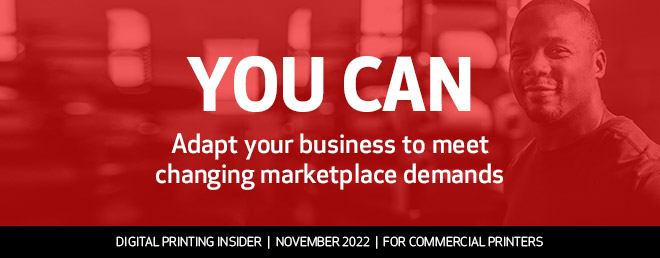Tipping Points, Epiphanies & Pivots:Commercial Printers Share their Strategies at thINK Ahead 2022
A highlight of every thINK Ahead Canon inkjet user conference is the opportunity to learn from other print providers who share the same challenges and goals. This year was no exception, with lots of conversations focusing on how companies are strategically responding to shifting realities and disruptions in the marketplace.
During a session for commercial printers entitled The Power of Planning for the Future, Hunter Johnson, president and CEO of JPS Graphics Corporation; Tom Chapleau, executive vice president of Quantum Group; and Jeff Alexander, founder and president of Alexander's Print Advantage, shared a glimpse into how they shaped their unique strategies for adapting to change and staying competitive.
Different Tipping Points
Presenter Karen Kimerer of K.L. Kimerer & Associates kicked off the conversation by noting that all the panelists agreed they “really aren’t the commercial printers they were a few years back,” given how much the industry has changed. “Strategy is often forced upon us,” Kimerer said. Then she asked the panelists, “So what was the tipping point when you realized you had to start making some changes in your business to stay healthy and grow?”
For Alexander, whose business focuses on web-to-print services and white label partnerships, the realities and pressures of evolving technology and its prominence as a driver in the industry came sooner than for other companies—as far back as Y2K.
“We realized then that we had to make big changes or else we wouldn't be able to stay in business,” Alexander said. “We recognized that if we didn't have technology behind it, we were just going to be out there trying to find a commercial job every day. Web to print was the first step, but it took a long time to evolve, because people weren't ready for it.” The upshot, according to Alexander, is the experience spurred renewed focus on developing better ways to leverage automation to drive print.
“We recognized that if we didn't have technology behind it, we were just going to be out there trying to find a commercial job every day.” — Jeff Alexander, Founder and President, Alexander's Print Advantage
At Quantum, Chapleau and his team realized not only their business model but also their audience was visibly changing. “We found ourselves meeting with people we had never met with traditionally,” Chapleau explained. “They were bringing in marketing folks telling us what they were trying to achieve. The conversations were not about ink or paper anymore. They were about achieving communication results. We were forced to ask ourselves, ‘How are we going to do this? How are we going to achieve this?"
With the acquisition in 2006 of a local all-digital Pitney Bowes mailing inserting shop, Quantum “kind of jumped into programming work and out of the conventional sheetfed that we were focused on at the time,” said Chapleau. Since then the company has begun servicing a lot of regulated industries—like finance, healthcare, and pharma—and engaging in provider networks. “The buyer audience changing was really the turning point for us. We had to quickly pivot and change,” he concluded.
Like so many businesses in so many industries, JPS Graphics, a third-generation, family-owned book manufacturing business, directly felt the bottom-line impact of the COVID-19 pandemic. “We saw our revenue step down 23 percent in 2020,” Johnson said. ”So, it was really kind of survival mode—that mode where you get away from the focus on strategy to kind of any revenue is good revenue.” But the JPS Graphics team knew that kind of business model wasn’t sustainable. So, the company decided to take advantage of this time of disruption to analyze the market and their business and do a reset.
“At the time, we were servicing a lot of different customer segments,” said Johnson. “We were pretty diverse in our offerings. But we realized we needed to get back to asking the right questions: What do we want to do? What do we want to be? What should be our target markets and that core offering we want to build our business around?”
Different Epiphanies
After hearing three different answers to the question about the impetus to adjust their approach to the market, Kimerer asked the panelists to discuss not only what they determined to focus on but also what process they went through to make that determination.
“Audience change is a big deal, because ours continues to change,” said Alexander. “As we began doing web to print, we were focused on trying to provide services to franchisors for their franchisees. Then that began to change as more printers had access to web to print. So we continued to develop our technology and it became workflow. As we started doing products that were one-offs for customers, we had to have not only a lot of technology but also the workflow to track it.
“Since most workflow software was developed by people outside the print industry who really didn't understand what we were doing,” he explained, “we developed our own. We took various workflows coming in from customers and figured out ways to take all the different types of file input and streamline and automate them. Now, we've become definitely B2B, partnering with companies that fill the B2C role themselves and mostly have their own apps or websites where they're bringing in orders for print. Then we become their printer and their fulfillment. Today, the orders are coming in every night rather than having to go out and find that job and bring it in each time.”
By taking a step back, Quantum “found we had a great handle on our costing structure for the manufacturing portion, but there was no consideration of any of the ancillary costs around it,” Chapleau said. “There was stuff we weren't getting paid for. Customers or things we thought we were good at weren't making us any margin. We had to look at what really was a good fit and reset the mindset from a really departmental approach to workflows to support growth as well as increase margin on existing business. There was a lot of efficiency to be gained by making some minor changes that weren't very costly for us."
“Customers or things we thought we were good at weren't making us any margin. We had to look at what really was a good fit and reset the mindset . . . to support growth.” — Tom Chapleau, Executive Vice President, Quantum Group
Since the reset, engaging with provider networks has been very important to Quantum’s growth. “We’re the backend for a couple of large direct-to-consumer customers, and we are looking to expand that as well,” said Chapleau. “So our growth has really not been on the conventional side. It's really been in the automation and the program work.”
At JPS Graphics, the answer was niching and specialization. “We analyzed the core of our business and looked at a lot of financial data—what is our revenue by segment, what is our revenue and profitability by offering,” said Johnson. “Turned out about 60 percent was in learning organizations—corporate training and K–12 education. We also saw a big tailwind, including government stimulus, in this sector. So, we committed to making bold decisions and really leaning into books and kitting for this market, including investing in a new Canon varioPRINT iX-series sheetfed inkjet press in March 2021 even before the back-to-school rush came on. By Q3, we posted the best sales month ever and added a second shift! We’ve also strategically pivoted our wide format division to do more short-run custom boxes for packaging our kits.”
Doing Things Differently
After additional discussion about putting those epiphanies into practice and the impact on each company’s workforce, Kimerer posed a final question to the panelists: What do you wish you would've done differently in the last couple of years?
For Chapleau, it was avoid delay and misdirection. “We spent a lot of time in spreadsheets, focused a lot on measurement, but we got lost down that rabbit hole and we lost focus on product and service,“ he said. “Product and service should be number one always. The spreadsheets should help you improve that offering.”
Johnson agreed, saying their biggest mistake was “focusing less on the actual purpose of our business and more on the financial milestones. Our target market around learning organizations—that's our purpose, to enable learning, whether it's student learning or professional learning. That's something we've tried to do a better job of this year.”
“[Our biggest mistake] was focusing less on the actual purpose of our business and more on the financial milestones.” — Hunter Johnson, President and CEO, JPS Graphics Corporation
But Alexander took a different tack, saying, “We don't dwell on that so much, because we see failure as an opportunity to learn and to help us in the future. We've been very fortunate that way, because we're family owned. We're independent, we can just do it. And I love that part of it. We're not afraid to fail.”
A Reason to thINK
Opportunities to learn together like this session are what make thINK—the industry’s largest independent community of Canon inkjet users—and the annual thINK Ahead conference so valuable. To learn more about becoming a member visit thINKForum.com.
SIDEBAR
Strategy Reading List
The panelists each named a book that has influenced how they look at their business today and how they are going to move it forward.
Jeff Alexander
Atomic Habits: An Easy & Proven Way to Build Good Habits & Break Bad Ones by James Clear
“There's a section about the 1% factor. And I think that we're at a point now where that 1% improvement is really critical—pushing forward in small increments so we can deliver to our customers better.” JA
Hunter Johnson
Traction: Get a Grip on Your Business by Gino Wickman
“As a leadership team we read the book, and EOS has become truly the operating system for our business and the reset on our purpose and values.” HJ
Tom Chapleau
Traction: Get a Grip on Your Business by Gino Wickman
Scaling Up: How a Few Companies Make It. . .and Why the Rest Don’t by Verne Harnish
“I think it's worthwhile to just be extremely disciplined in how you're making progress in all the key areas of the company. So having a structure to follow and adhere to is very helpful.” TC
Did you know?
Canon Solutions America offers its inkjet customers free access to the valuable resources, learning experiences, and networking opportunities presented by thINK, an independent community of inkjet users, solution partners, and print industry experts.

